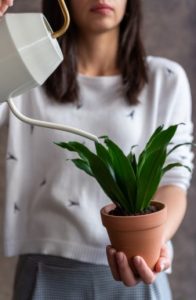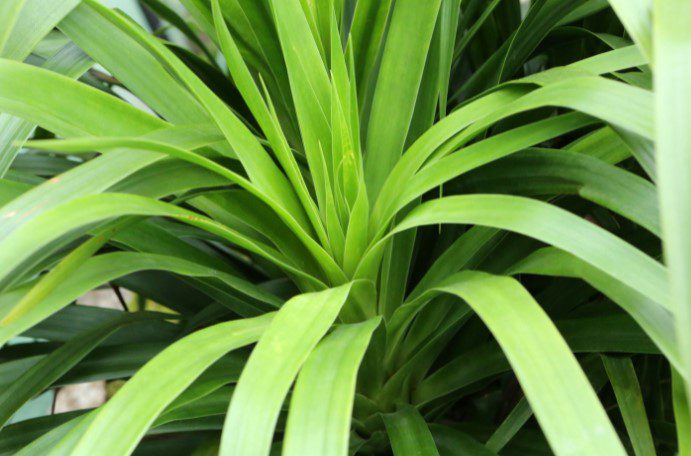Dracaena
Squat, with a full head of strappy, green leaves, dracaena is an ideal houseplant. The plant tolerates low light, low humidity, and even temporarily dry soil.
With age, dracaena’s appearance changes, becoming graceful as starbursts of leaves cap the lanky and leafless stems.
No dracaena goes from being squat and stately to lanky and graceful overnight.
Unfortunately, that intermediate stage, with a tuft of leaves looking as if it was just plopped onto a short, leafless stem, is neither stately nor graceful. This is when many gardeners tire of their dracaenas, then relegate them to their compost piles.
A more forgivable shortcoming of dracaenas is that they eventually grow too tall. Where it’s native, in Africa, it grows about 20 feet high, which is too tall for the average living room.
Yet dracaena isn’t the kind of houseplant that you can prune a little each year to keep it within bounds because the whole plant often consists of nothing more than a single, bare shoot with leaves only at its top.
You could lower a lanky plant by lopping the stem back to whatever height suits you. This treatment will seem brutal and not recommended more than once every few years, but be patient. The plant will look like nothing more than a stick for a while, but eventually, one or two new sprouts will appear near the cut.
You can also make a giant dracaena into a new, better-proportioned plant by air-layering. Do this by wounding the stem with a knife a few feet below the tuft of leaves, wherever you would like roots of your new plant, then swathing the wounded area in a ball of moist sphagnum moss.

Keep the moss moist and in place with a piece of plastic wrap tied above and below it. Exclude light by covering the plastic with aluminum foil.
Periodically peek beneath the foil for roots growing out from the stem and into the sphagnum moss.
When roots finally fill the moss, lop off the stem just below the moss, then pot up your newly rooted plant.
More Dracaena Info
Some species are classed as “false palms” due to their woody, leafless trunks and frond-filled crowns, although unrelated to true palms. Further confusion comes with the nomenclature in this group of plants, with species and cultivars often sold as cordylines.
The corn plant (Dracaena deremensis) is a tropical African evergreen tree popular in Europe as an indoor plant since the mid-1800s—and in the U.S. since the early 20th century.
Dracaena reflexa is commonly referred to as Song of India. This broadleaf evergreen native to the Indian Ocean islands typically grows to a height of 18 to 20 feet in the wild but is adaptable when grown indoors.
It can be used as a tabletop or floor specimen, depending on your preferences. Expect it to reach a top height of three to six feet when used as a house plant.
Cordyline australis is often labeled as Dracaena terminalis and given the common name red dracaena. The two genera can be distinguished by looking at the root structure.
Dracaena roots are smooth and yellow to orange and have a non-creeping habit, while Cordyline roots are creeping, white and knobbly in appearance and are susceptible to root rot.
Since Victorian times, the plants have been used indoors, but only in the past 10 years have they reached the bestseller list.
Their durability as a houseplant makes them good options for experienced and novice gardeners. Dragon tree Dracaena marginata AGM and D. Draco AGM are perhaps the easiest to tend to and will tolerate shaded areas of the house, low winter temperatures, and bear up to neglect from their owners.
The remaining species need higher temperatures, careful watering, and misting. D. godseffiana is different from its relatives and has no similarity to other plants in the genus.
It also makes a good retail plant for novice gardeners as it withstands lower temperatures and drier air conditions.
However, problems can arise. Leaves that turn brown tips and yellow edges show dry air. This can be resolved by misting. Soft and curled leaves with brown edges indicate the temperature is too low.
Leaves with brown spots show underwatering, while leaves with bleached dry patches mean they are getting too much sun. Problems with spider mite, mealybug, and scale can also occur.
The plants can offer more than just style and ease of care. NASA research, which can be found at www.dracaena.com, shows dracaenas are among the best plants for absorbing cancer-causing chemicals found in home and office environments.
In its list of top 10 plants for tackling the problem, four were from the Dracaena genus – D. marginata, D. fragrans ‘Massangeana’, D fragrans ‘Janet Craig’ and ‘Warneckei.
Growing a Dracaena Plant
The stems of the houseplant Dracaena are known as canes. They can be cut at any time to maintain control.
Dracaena houseplant varieties D. fragrans or D. deremensis can grow up to 6-10 feet tall (2-3 m.), so it is important to control height by trimming canes on older plants. In a matter of weeks, new foliage will grow just below the cut.
Replant the cane with another plant. Dracaena houseplant care is to keep the soil moist but not soggy.
Poor drainage or over-watering can cause yellowing leaves and drooping leaves. How to care for dracaenas includes choosing a well-draining soil to grow them. Proper fertilization is another important part of caring for dracaenas.
Use a balanced fertilizer for houseplants to fertilize every two weeks during spring and summer. Fall fertilization should be reduced to once per month.
If you are growing dracaena plants, it is good to stop feeding them during the winter months. The plant will benefit from the time of dormancy. If you are growing dracaena plants, make sure to place them in bright indirect light.
For example, a sheer curtain placed in front of a sunny window will help. The best room temperatures are between 60 and 70 degrees F (15-21 C.).
Night temperatures are about ten degrees lower. The dracaena can tolerate cold temperatures as long as it is not too cold.
You now have essential knowledge of how to care for dracaena plants. Why not start dracaena-friendly houseplants in your own home?
In the video below you can see Dracaena sanderiana, a flowering plant species belonging to the Asparagaceae family that is native to Central Africa. The plant is frequently referred to as “lucky bamboo”


























